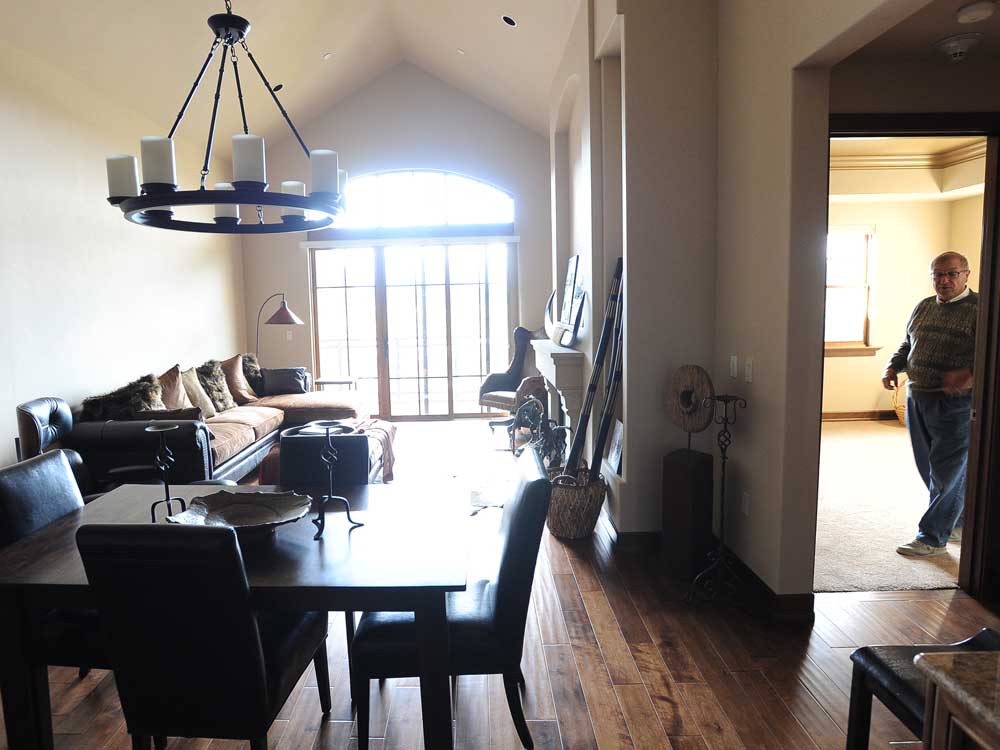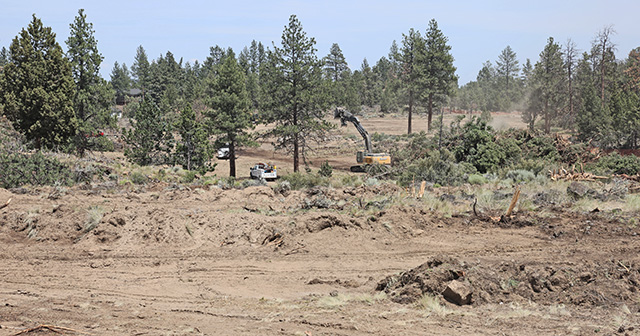Planning Bend’s housing future
Published 12:00 am Friday, October 17, 2014

- Ryan Brennecke / The BulletinRick Brickner, of Boise, walks through a Bend rental property he and his wife, Daria, were interested in. Like many boomers, the couple wants to downsize from a single-family home, but Bend’s rental market for condos and townhomes is very limited.
Rick Brickner and his wife, Daria, were having dinner at a downtown Bend restaurant a couple of years ago when she asked him an interesting question: “Could you move here?”
The Brickners, respectively 61 and 58, passed through Bend a number of times as they traveled from their home in Boise, Idaho, to vacation on the Oregon Coast. They slowly fell in love with the city and eventually decided it was where they wanted to retire.
But one thing is standing in the way of this dream.
Even though they have a budget of almost $2,500 a month, the Brickners are having a hard time finding a nice 2,000- to 2,400-square-foot townhouse or condominium to rent that meets a few basic criteria and is within walking distance of a commercial district such as downtown Bend or the Old Mill District.
“I know it will be very difficult to find what we’re looking for,” said Brickner, who has given himself a 50-50 shot at finding the type of rental home he and his wife want before his moving truck arrives in Boise at the end of this month.
Recognizing predictions that Deschutes County’s senior population will more than double over the next 15 to 20 years, Bend planners reviewed the city’s housing inventory and found it does not have the type of housing units, or enough of them, that baby boomers will be looking for when they retire.
They’re including a call to build more of these units — a mixture of small, cottage-style single-family homes, duplexes, triplexes and condominium/townhouse complexes — as they move forward with a long-range plan that’s supposed to guide the city’s future development.
“We need to diversify,” Senior Planner Brian Rankin said as he talked about the city’s need to build more multifamily housing units and fewer traditional, detached single-family homes so it can be ready for this demographic trend. “Ultimately, it’s about creating more choices in the marketplace.”
The boomers
When they sent back Bend’s request to expand its urban growth boundary in 2011, officials with the Oregon Land Conservation and Development Commission ordered city planners to pay close attention to current demographic trends and figure out how or whether they will affect the city’s growth in the years to come.
One of these trends involves the country’s 76 million baby boomers.
Population projections from the Oregon Office of Economic Analysis predict that Deschutes County’s senior population will more than double over the next 10 to 15 years because of the sheer size of its current boomer population — the youngest member of this generation turns 65 in 2029 — and the fact more and more boomers are expected to move to the region in the future because they see it as a good place to retire (see “Population boom”).
Between one of every six and one of every seven Deschutes County residents (roughly 15 percent) are 65 or older; by 2029, residents age 65 and older will make up 25 percent of the population. That age demographic affects housing.
“More than 50 percent of older Americans have said their next house will be smaller than their current house,” Rankin said, citing surveys that show many boomers are thinking about downsizing as they get ready to retire. “At some point, they will be forced to, or choose to, live in a housing unit that has fewer needs.”
Brickner and his wife had this goal in mind when they started looking at houses in Bend on Tuesday afternoon.
While Brickner and his wife loved the 3,000-square-foot home they built in Boise 14 years ago, Brickner said that when he gets older, he does not want to continue doing the type of maintenance and yardwork that living on the property required.
Brickner said there’s also no guarantee the housing market will continue to improve, which affects a decision to invest their retirement savings in another piece of real estate. He said many people learned this lesson when the housing market crashed five years ago and are also leery about buying a new home.
“There’s a lot of baby boomers who now realize owning a home is not necessarily a moneymaking proposition,” Brickner said, explaining why he and his wife want to rent their next home.
Brickner said his ideal place would be a nice townhouse or condominium that’s located in a development where someone else is responsible for keeping up the property’s yard work and other routine maintenance tasks. He also wants it to be located in an area where it’s easy to walk to nearby parks, grocery stores, restaurants and other amenities.
Over the past year, Brickner said he’s seen a couple of these developments pop up with vacancies on real estate ads. But these units are often available only on a short-term or seasonal basis because they’re owned by a boomer who plans to live there full time when he or she is ready to retire.
“It’s always hard to find townhomes or condos in small cities,” Brickner said, accepting the fact he may have to settle on one or two of his wishes to find a place. “I don’t think you’re going to see (more of these units) in Bend anytime soon.”
The need
Rankin said Bend’s current housing mix is one of the reasons Brickner might be having such a hard time finding the type of home he wants. According to the city’s records, detached single-family homes made up about 71 percent of the city’s total housing units in 2008.
Rankin said that’s because detached single-family homes were favored over any other type of housing when most of the residential development inside the city and the area that Bend annexed during the 1990s took place.
“Generally, what we see now is a continuation of what we’ve seen in the past,” Rankin said, explaining that because this type of home continues to be so popular, it now makes up closer to 75 percent of the city’s housing inventory.
But while this trend is good for people who either have families or are looking to start a family, it doesn’t necessarily meet the needs of aging boomers who may be ready to downsize or reduce maintenance .
It also doesn’t work for millennials, many of whom are expected to forgo homeownership in part because they’re likely to be carrying around record amounts of student debt when they graduate from college.
Members of this generation — who were born between 1980 and 2000 — will make up about 24 percent of Deschutes County’s population in 2030, according to the state’s estimates.
“Mobility is kind of an issue as well,” Rankin said, giving another reason the millennials may forgo buying their first home. “Younger people just tend to bounce around as they look for good jobs and experiment with places to live.”
Rankin said a committee involved in the city’s long-term urban growth boundary expansion process recently approved a target housing mix for 2030 that would be 68 percent to 70 percent detached single-family homes. He said this goal could be met by providing incentives or using the city’s zoning process to encourage developers to build more multifamily units such as the ones the Brickners are looking for.
But here, too, is another problem, because like boomers, millennials have expressed a strong desire to live in a neighborhood or community where they can walk to stores, restaurants and other amenities. Rankin said meeting this goal could be difficult because there is a dearth of empty space around the city’s main commercial centers that could be used to build new townhomes, condominiums and other multifamily housing units.
He said if the city wants to move toward its goal of building more multifamily housing, it may need to consider putting housing units on top of existing businesses, such as the apartments above Jackson’s Corner on Bend’s west side, or building new developments on available land that include a mixture of commercial and dense residential property.
“We have to figure out how many and what kind of housing units we want to build,” Rankin said, explaining it will probably be another two years before the city has finished its current long-term development plan. “And then we have to figure out where we are going to put them.”
— Reporter: 541-617-7816, mmclean@bendbulletin.com







